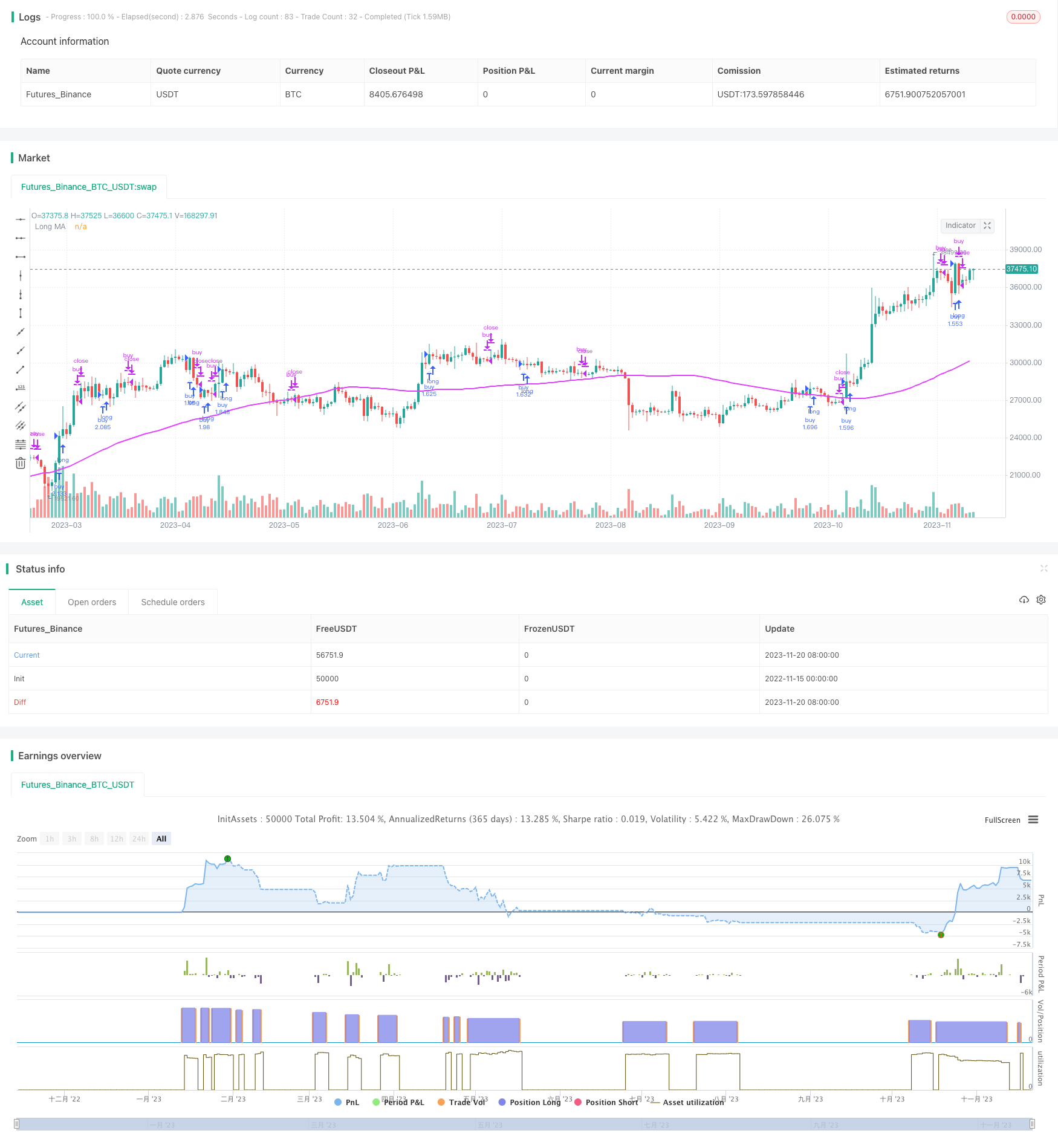이중 이동 평균 역전 전략
저자:차오장, 날짜: 2023-11-22 10:07:19태그:

전반적인 설명
이 전략의 주요 아이디어는 빠른 이동 평균과 느린 이동 평균의 교차를 사용하여 시장 트렌드를 판단하고 단기 및 장기 이동 평균이 역전될 때 위치를 취하여 트렌드를 추적하는 효과를 달성하는 것입니다.
전략 논리
- 단기 이동 평균 기간 shortma (7일 기본) 및 장기 이동 평균 기간 longma (77일 기본) 를 설정합니다.
- 짧은 MA가 긴 MA를 넘을 때, 그것은 구매 신호 및 기록 바로 결정됩니다. 긴 MA는 상승 추세가 시작되었음을 암시합니다. 짧은 MA가 긴 MA를 넘을 때, 그것은 판매 신호 및 기록 바로 결정됩니다. 긴 MA는 상승 추세가 끝났다는 것을 암시합니다.
- 바스 시인치 값을 비교하십시오. 짧은 MA가 아래로 넘어가면서 더 많은 바가 많을수록 상승 추세는 더 오래 지속되었습니다. 짧은 MA가 위로 넘어가면서 더 많은 바가 많을수록 역전 신호가 강합니다.
- 판매 신호의 바스센스가 구매 신호의 바스센스보다 크면 구매 신호가 발사됩니다. 구매 신호의 바스센스가 판매 신호의 바스센스보다 크면 판매 신호가 발사됩니다.
- 기본적으로 이것은 트렌드 반전 지점을 탐지하기 위해 빠르고 느린 MA의 교차 반전을 사용하는 이중 MA 반전 전략입니다.
장점
- 일부 잘못된 신호를 필터하기 위해 이중 MAs를 사용합니다
- 비교가 잘못된 파업과 가까운 가격 반전을 피하기 때문에 추가 바
- 이해하기 쉽고 실행하기 쉽다
- 사용자 정의 가능한 MA 매개 변수는 다른 기간과 시장에 적합합니다
위험성
- 듀얼 MA 전략은 더 빈번한 거래 신호를 생성하는 경향이 있습니다.
- 잘못된 MA 매개 변수 조정으로 더 긴 트렌드를 놓칠 수 있습니다.
- 장기 MAs가 깨질 때 손실을 멈추는 것은 멀리 떨어져 있어 더 큰 마감으로 이어질 수 있습니다.
- 코일과 오시슬레이션을 효과적으로 필터링 할 수 없습니다.
개선 방향
- 다른 지표들을 추가하여 다양한 시장에서 위프사를 피합니다.
- 스톱 로스 메커니즘을 추가
- MA 매개 변수 조합을 최적화
- 시장 주기를 기반으로 MA 매개 변수를 동적으로 조정합니다.
요약
이 전략은 전반적으로 명확하고 이해하기 쉬운 논리를 가지고 있으며, 트렌드 반전 지점을 탐지하기 위해 빠르고 느린 MA 반전을 사용합니다. 이론적으로는 트렌드를 효과적으로 추적 할 수 있습니다. 그러나 실제 구현에서는 여전히 알고리즘 자체를 최적화하고 매개 변수를 조정하여 더욱 견고하고 실용화해야합니다.
/*backtest
start: 2022-11-15 00:00:00
end: 2023-11-21 00:00:00
period: 1d
basePeriod: 1h
exchanges: [{"eid":"Futures_Binance","currency":"BTC_USDT"}]
*/
//@version=3
strategy("Up Down", "Up Down", precision = 6, pyramiding = 1, default_qty_type = strategy.percent_of_equity, default_qty_value = 99, commission_type = strategy.commission.percent, commission_value = 0.0, initial_capital = 1000, overlay = true)
buy = close > open and open > close[1]
sell = close < open and open < close[1]
longma = input(77,"Long MA Input")
shortma = input(7,"Short MA Input")
long = sma(close,longma)
short = sma(close, shortma)
mabuy = crossover(short,long) or buy and short > long
masell = crossunder(short,long) or sell and short > long
num_bars_buy = barssince(mabuy)
num_bars_sell = barssince(masell)
//plot(num_bars_buy, color = teal)
//plot(num_bars_sell, color = orange)
xbuy = crossover(num_bars_sell, num_bars_buy)
xsell = crossunder(num_bars_sell, num_bars_buy)
plotshape(xbuy,"Buy Up Arrow", shape.triangleup, location.belowbar, white, size = size.tiny)
plotshape(xsell,"Sell Down Arrow", shape.triangledown, location.abovebar, white, size = size.tiny)
plot(long,"Long MA", fuchsia, 2)
// Component Code Start
// Example usage:
// if testPeriod()
// strategy.entry("LE", strategy.long)
testStartYear = input(2017, "Backtest Start Year")
testStartMonth = input(01, "Backtest Start Month")
testStartDay = input(2, "Backtest Start Day")
testPeriodStart = timestamp(testStartYear,testStartMonth,testStartDay,0,0)
testStopYear = input(2019, "Backtest Stop Year")
testStopMonth = input(7, "Backtest Stop Month")
testStopDay = input(30, "Backtest Stop Day")
testPeriodStop = timestamp(testStopYear,testStopMonth,testStopDay,0,0)
// A switch to control background coloring of the test period
testPeriodBackground = input(title="Color Background?", type=bool, defval=true)
testPeriodBackgroundColor = testPeriodBackground and (time >= testPeriodStart) and (time <= testPeriodStop) ? #00FF00 : na
bgcolor(testPeriodBackgroundColor, transp=97)
testPeriod() => true
// Component Code Stop
if testPeriod()
strategy.entry("buy", true, when = xbuy, limit = close)
strategy.close("buy", when = xsell)
더 많은
- 크로스 페리오드 돌파구 시스템
- 이중 트렌드 라인 지능 추적 BTC 투자 전략
- RSI 및 T3 지표에 기초한 PMax 브레이크아웃 전략
- RSI 이중 교차 역전 전략
- 123 반전 이동 평균 컨버전스 디버전스 조합 전략
- 하이킨 아시 하이스 로브 채널 동적 이동 평균 거래 전략
- 양적 황금 십자가 전략
- 이치모쿠 클라우드와 MACD 모멘텀 라이딩 전략
- 다중 이동평균 파업 전략
- 스토카스틱 오TT 거래 전략
- 퀀트 트레이딩 이중 클릭 역전 전략
- 피보나치 채널 기반 촛불 역전 거래 전략
- 동적 이동 평균 트렌드 크로스오버 전략
- 볼링거 밴드 표준 오차 파업 전략
- VSTOCHASTIC RSI EMA CROSSOVER VMACD 웨이브파인더 전략과 결합
- 멀티 타임프레임 동적 백테스팅 전략
- 반전 단기 브레이크아웃 거래 전략
- 이중 이동 평균 크로스오버 화살표 전략
- 모멘텀 오스칠레이션 거래 전략
- 다중 시간 프레임 RSI+CCI+볼링거 밴드 DCA 전략